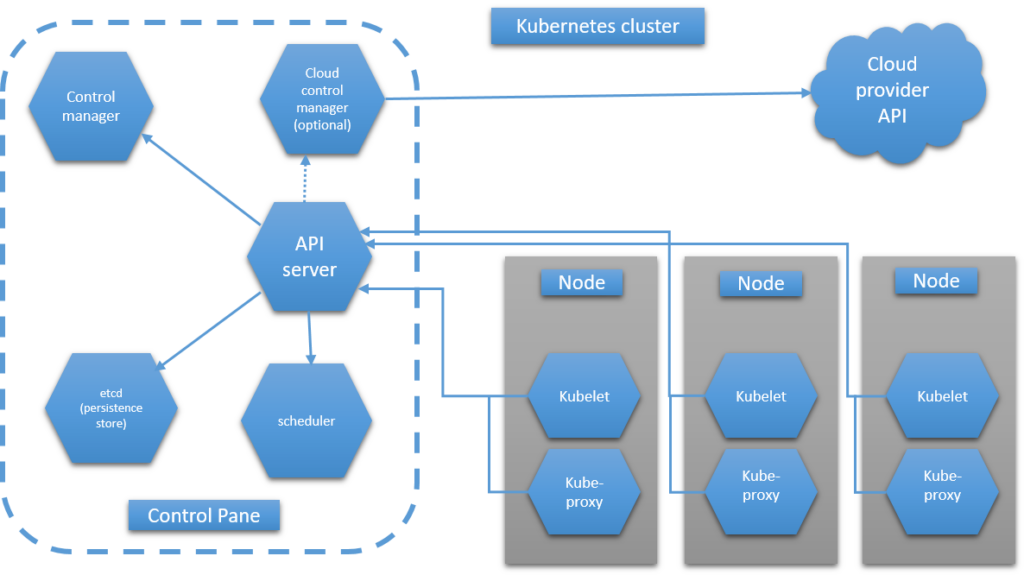In the realm of modern software development and deployment, containerization has gained significant popularity. Containers used for Packaging applications and their dependencies Containers provide a lightweight and isolated environment that can run consistently across different computing environments. However, managing and orchestrating a large number of containers can be a complex task. This is where Kubernetes comes into play.

Kubernetes, often referred to as K8s, is an open-source container orchestration platform. K8s automates the deployment, scaling, and management of containerized applications. Initially developed by Google and now maintained by the Cloud Native Computing Foundation (CNCF). Kubernetes offers a robust framework for effectively managing containerized workloads across a cluster of machines.
At its core, K8s aims to address the challenges associated with deploying and scaling containerized applications. It abstracts the underlying infrastructure and provides a unified Application Programming Interface (API). Containers, storage, networking, and other resources are manged by these APIs. With Kubernetes, developers can focus on writing code. And it also hep in defining application requirements without being burdened by the complexities of the underlying infrastructure.
Key Concepts in Kubernetes
- Cluster: A Kubernetes cluster comprises a collection of nodes responsible for hosting the containers. Typically, a cluster consists of a master node that manages the cluster and multiple worker nodes where the containers run.
- Pods: Pods are the smallest deployable units in Kubernetes. They represent one or more containers that are deployed together on the same host. Containers within a pod share the same IP address and can communicate with each other using the localhost interface.
- Services: Services provide a stable network endpoint for accessing a set of pods. They facilitate load balancing and dynamic service discovery within the cluster, enabling containers to communicate with each other reliably.
- ReplicaSets: ReplicaSets ensure that a specified number of identical pods are always running. If a pod fails or gets terminated, the ReplicaSet replaces it with a new one. And ensuring high availability and fault tolerance.
- Deployments: Deployments offer a declarative approach to managing application deployments and updates. They define the desired state of the application. And Kubernetes automatically handles the rollout and rollback of changes. And it ensuring the application remains in the desired state.
- ConfigMaps and Secrets: ConfigMaps store configuration data as key-value pairs. While Secrets store sensitive information such as passwords or API keys. Kubernetes allows these resources to be injected into containers. Thease are injected as environment variables or mounted as files. It help in simplifying the management of application configuration.
Benefits of Kubernetes
- Scalability: Kubernetes enables applications to scale horizontally by adding or removing pods based on workload demand. This scalability ensures optimal resource utilization and allows for handling traffic spikes without manual intervention.
- High Availability: Kubernetes incorporates self-healing capabilities. If a pod fails or a node becomes unavailable, Kubernetes automatically reschedules the affected pods to healthy nodes. And ensuring the availability and continuity of applications.
- Load Balancing and Service Discovery: Kubernetes provides built-in load balancing and service discovery mechanisms. It evenly distributes network traffic across pods. And enables services to be discovered by their names, abstracting the complexity of managing network configurations.
- Portability: Kubernetes is designed to be platform-agnostic and works across various cloud providers and on-premises environments. It empowers organizations to avoid vendor lock-in and facilitates the smooth migration of applications between different infrastructure setups.
- Extensibility: Kubernetes offers a rich ecosystem of plugins, extensions, and APIs, allowing developers to customize and extend its functionality. This extensibility enables seamless integration with other tools and services for logging, monitoring, and more.
Conclusion
Kubernetes has emerged as the standard for container orchestration in the cloud-native ecosystem. Its powerful features and robust architecture empower developers to deploy and manage applications efficiently, providing scalability, high availability,